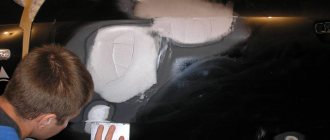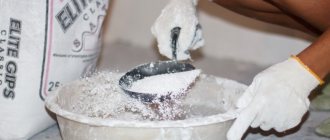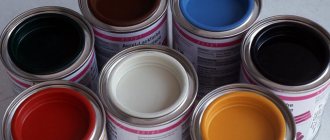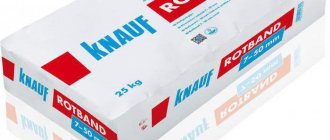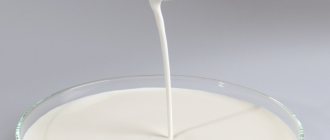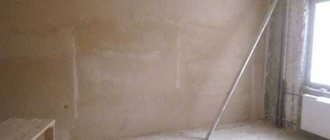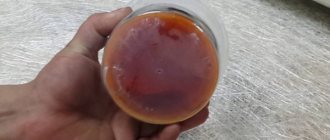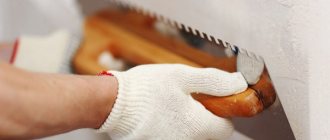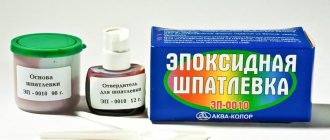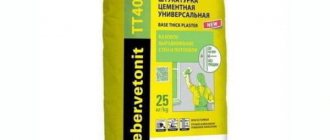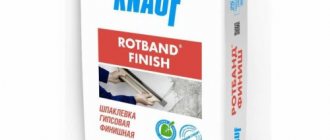Any automotive putty is used to restore the body surface after physical damage or destruction by corrosion. Its use allows you to level the surface and seal through holes. Fiberglass car putty is one of the varieties of this material. Its specific composition has both its pros and cons. Putty with fiberglass requires compliance with specific rules, without which a normal result cannot be achieved.
General information about the material
Fiberglass putty is a composition based on an unsaturated modified polyester resin, reinforced with special fibers and is a two-component product. In its original form, any polyester resin is quite hard, so various targeted additives are added to it to enhance ductility and elasticity. The fiberglass in the putty is intended to further enhance the strength of the material after drying.
Surface preparation
At the first stage, it is necessary to prepare the surface for subsequent processing. To do this, thoroughly clean the car from dirt and dust and examine its surface for the presence of protruding bumps (putty is not able to hide such serious defects). If there is a raised bump, press the surface of the bump slightly and make sure that it does not return to its original position after applying the leveling compound.
Puttying these types of areas requires special skills, so it is better to contact a specialized center to fix the problem. If you nevertheless decide to putty the car body with your own hands, then you need to remove the protrusion as carefully as possible, especially for subsequent partial painting of the surface.
Next, you need to remove the top paint layer and rust using coarse sandpaper to ensure a more reliable fixation of the putty. Removal of paint should only be carried out on the putty area, and it is advisable not to touch the nearest surface.
Important! We recommend cleaning the surface from the paint until clean, shiny metal appears.
Putty composition
The main active substance of the putty is polyester resin - a viscous mass that is a little reminiscent of honey. It plays the role of a binding component and ensures the strength of the finished mixture. The composition also includes fiberglass particles that reinforce the mass and act as a filler. They increase the hardness of the coating after drying, so that it does not shrink and cracks do not appear.
Depending on the production technology, glass fiber threads are:
- Long. They are created in a continuous production process where molten glass is turned into thin streams and wound onto a drum. After hardening, the fibers pass through a special installation, where they are coated with an emulsion of starch, gelatin and plasticizers.
- Short. They are obtained by blowing liquid glass with steam or air. The finished fibers are short in length and resemble wool.
Fiberglass fiber
Most often, short reinforcing fibers are used in the production of putty. The material also contains styrene, which enhances elasticity. A hardener is sold in a separate package - this liquid substance, after mixing with the base, starts a chemical polymerization reaction, and the putty begins to harden.
Properties
Fiberglass putty is ideal for smoothing out various defects, chips, cracks and pits. It can be applied to products of a small or large area, and in the latter case a sprayer can be used to distribute it. There are special types of auto putties with reinforcing fibers for plastic - they have the highest quality of adhesion to this particular material.
Removing dents with fiberglass putty
The main properties of reinforced putties are as follows:
- vibration resistance;
- high strength;
- durability;
- short curing time;
- elasticity, stretchability;
- resistance to mechanical damage;
- Can be used on any hard surface.
Scope of application of putty
Most often, the material is used to seal small and medium-sized defects, for example, scratches and cracks, microchips. Some products are even suitable for sealing through and large holes in plastic and metal parts. The putty is ideal for working with all types of steel - galvanized, alloyed, galvanized, etc., as well as aluminum. It is no less suitable for processing products made of polyester laminate, fiberglass, and for old paint and varnish and primed coatings. In construction, the material is used when working with:
- concrete and cement;
- tree;
- natural stone;
- artificial stone.
After drying, polyester putties are coated with a layer of paint to further protect their surface. It is not recommended to apply car putties on substrates coated with etching and acid-curing primers, as well as on thermoplastic and viscoelastic (non-solid) materials.
How to divorce?
Automotive putties are sold in two-component form: putty mass (or base) and hardener. The base is a plastic substance that has good adhesion and pliability under external mechanical influence. The hardener is used to convert liquid putty into a solid mass.
The vast majority of modern putties are diluted according to the same scheme: 2-4 grams of hardener per 100 grams of putty. In this case, the choice of the exact proportion depends on weather conditions and requirements for hardening speed. In dry, hot weather, 2 grams is enough. If the weather is humid and cool, or accelerated curing is required, the proportion can be increased to 4-5 grams per 0.1 kg portion of base.
Mix the base with the hardener slowly, with soft plastic movements and always by hand. Do not beat car putty using mechanized means. This can saturate it with air, which will weaken the frozen layer on the workpiece.
If, after adding the hardener and mixing, the putty has acquired a noticeable reddish tint, you should not use it. It's better to prepare a new portion. Excess hardener may cause a red tint to appear through the paint.
How to dilute correctly, in what proportion to stir and cook
You can prepare the putty mixture either on a small piece of organic glass or on a special tool. But, despite this, many craftsmen prefer to use only two spatulas of different sizes. They should be cleaned immediately after work, before the remaining material has completely hardened.
If this happens, it will be quite difficult to remove them later. And this is important so that even the smallest irregularities are not left on the tools, as this may affect the quality of further work with their help. Additionally, they can be cleaned using a special solvent.
Storing putty involves settling of solid particles from its composition and the formation of a film of resin on the surface. As a result, before using this material, it is worth stirring it very thoroughly, thereby obtaining a homogeneous mass with which you can further work.
In addition, in this case, the correct mixing ratio can be achieved, since the filler will not participate in the reaction. To remove the putty from the container in which it is located, you need to use only clean tools.
Residues on them may react adversely with the material. This can affect its quality.
The putty should be applied to the surface using a spatula. They can be made from thin steel or ordinary stainless steel.
Application
There are also products made of rubber or plastic. They can also be quite convenient in some cases. If you need to finish fairly large surfaces, you can also use a construction spatula for finishing work. In this place about a spatula for puttying walls. A ruler can also be useful to control the shape of the sanded surface.
Polyester putty is a material consisting of two components. They must be mixed immediately before work.
In this case, the resin with a hardener, which acts as a catalyst, can properly level the surface.
Polyester
In this case, you should definitely follow the proportions established by the product manufacturers. The putty should only be applied in a thin layer. A layer that is too rough will not allow you to obtain a high-quality coating.
After preparation, you need to work with the putty in a fairly quick time - from 5 to 10 minutes. That is why the layer should be applied in a short time and very precisely.
It is because of this that there is no need to mix components in larger quantities than required.
It is worth highlighting two features of this process:
- If too little hardener is used, the material will not cool in the required time. As a result, sanding will be quite difficult, since the putty will clump into clumps, resulting in scratches and unevenness. Here about mechanized;
- if there is a small amount of hardener, the material will not cool quickly. It will contain an active catalyst that will react with the resin and pigments. Subsequently, uneven coloring will appear on the surface, spots will appear, and the contours of the painted areas will become noticeable.
It is in connection with the above-mentioned features of diluting putty that it is necessary to adhere to the instructions for use and the manufacturer’s recommendations.
For more information on how to properly dilute putty, watch the video:
How to apply car putty correctly?
There are simply no universal answers to the question of how to putty correctly. Each master works in his own style. However, there are a few general recommendations that most bodybuilders adhere to.
- Work out in advance the question of which putty is best to eliminate the defect in your specific case.
- You need to prepare as much putty at a time as is required to treat one element or one defect. The hardener will turn the putty into a wax-like mass unsuitable for application in 5-7 minutes.
- Choose a spatula that is suitable for a particular case. There is no point in using a large wide spatula to stretch an area 3 times smaller than the spatula itself. The same applies to large areas of treatment: you should not try to pull them out with small spatulas.
- There is no need to try to immediately bring the surface to the ideal using only spatulas. The main thing is to fill the defective area well and carefully. And micro-irregularities and “snot” will be removed with sandpaper.
Experienced body workers work slowly, but without breaks within the framework of one defect.
Advantages and disadvantages
Putty based on reinforcing glass fibers and polyester resin has a lot of undoubted advantages:
- possibility of application in a fairly thick layer;
- no shrinkage after drying even with thick-layer application;
- no cracking during operation;
- strength, ability to be used to repair complex damage;
- resistance to vibrations and vibrations of surfaces, which only increases its popularity among auto repair specialists;
- rapid hardening, initial setting within 20-30 minutes;
- possibility of grinding on the first day;
- resistance to atmospheric factors;
- moisture resistance, no damage due to temperature changes, exposure to ultraviolet radiation.
Application in a thick layer is allowed.
The disadvantages of car putty include its toxicity, because the composition contains a very harmful solvent - styrene, which has a negative effect on the human body. You need to work with the product quickly, literally within 5-8 minutes, otherwise it will become viscous and will not be leveled properly.
Beginners often encounter difficulties regarding the speed of applying the composition, so they will have to practice on a rough surface in advance. Experience is also needed to give the composition the desired shape, especially when filling through holes and chips of complex configuration.
Tools and materials for work
Before diluting the mixture, you need to make sure that you have all the necessary tools and consumables:
- a set of spatulas made of metal, rubber, plastic (it will be more convenient to choose the appropriate one in each specific case);
- sandpaper with grain size 60-240;
- rags or sponges;
- block for securing sandpaper;
- solvent for degreasing the base;
- special spray or powder composition to reveal defects;
- soil suitable for the base material;
- compressed air cylinder.
When selecting a spatula, it is necessary to take into account that a tool with a metal blade is more suitable for working with fairly smooth surfaces where there are defects of minor depth.
Spatulas made of rubber and plastic are used mainly for processing round, curved areas and corners. It is recommended to buy high-quality tools, since cheap ones often have nicks and leave micro-scratches, and also break quickly.
Criterias of choice
The composition is selected taking into account the following circumstances:
- The nature of the damage is through or blind.
- Heights of unevenness.
The choice also depends on what surface you plan to repair. Purchase a paste with good adhesion to this material.
Pay attention to the following parameters of the repair composition:
- Curing time.
- Minimum application temperature.
- Issue date and expiration date.
- Storage conditions.
- Porosity, grindability.
- Price.
Expensive compounds are easy to use and provide a durable, smooth coating.
Preparatory stage
It is best to apply the material to clean metal, but if necessary, you can even work on old paint or varnish. Peeling, crumbling coatings are removed using a metal spatula or power tools. Areas affected by rust are sanded, completely eliminating the spots. Narrow cracks are widened slightly to make it easier to seal them with putty. Then, in relation to the working surface, do the following:
- processed with sandpaper for matting;
- clean from dust with compressed air, wipe with solvent;
- allow to dry completely.
What is car putty
Automotive primer is a material intended for finishing a metal surface for the purpose of:
- alignment of various chips;
- eliminating macro- and microdamage;
- providing the necessary performance characteristics.
The purpose of the putty is to create a base for subsequent treatment of the body with automotive primer, enamel and other decorative materials.
Car putty has protective properties
Car putty has protective properties and serves to preserve the aesthetic qualities of the car. It prevents moisture from entering cracks, increases the anti-corrosion properties of the metal base and prevents various chemicals from entering it.
There are several types of car putties on the market today, designed for different purposes. In this case, a number of mixtures can be used for application to a plastic surface.
In any case, high-quality car putty must meet the basic requirements:
- be elastic;
- harden quickly;
- give a slight shrinkage;
- have a low specific gravity;
- have a high degree of adhesion to the materials from which car body parts are made;
- Easy to combine with primer and paint.
Correct use of putty allows you to update the look of any car, providing it with a perfectly smooth surface by eliminating all external defects.
Preparation of the composition
Before combining the base with the hardener, you need to thoroughly mix the main component, and then familiarize yourself with the mixing proportions indicated by the manufacturer. For measuring, you can use ordinary electronic scales, but it is important that they do not have a large operating error. The serving size should be such that it is completely consumed within a few minutes.
After combining the two components, the putty is kneaded well until a homogeneous mass is obtained, uniform in thickness and shade. If the solution remains poorly mixed, or the amount of hardener is small or too large, the putty will harden unevenly. Also, the material may completely peel off from the substrate.
Which company should you choose?
There are quite a lot of manufacturers of car putties, but in 2022, users and experts have identified several manufacturers whose products are of the highest quality.
The ranking of the best manufacturers of automotive putties included NOVOL, HB BODY PRO, CHAMALEON and UNIVERSAL. We included the most successful products from these manufacturers in the rating.
Applying putty
When working with fiberglass-based compounds, you must first prime the surface, then putty, and finally sand the coating.
Padding
Preferably highly porous wooden and concrete surfaces should be primed. The metal can be left uncoated with primer.
Puttying
Apply the finished mixture with a spatula and immediately level it, trying to get as smooth a surface as possible. At the same time, make sure that the layer thickness does not exceed the permissible one, but is not too small. Wait until the putty has completely hardened, then, if necessary, apply a second layer of the product. If necessary, use the powder for its intended purpose to reveal defects.
Grinding
This stage is required to perfectly level the coating and eliminate even the smallest flaws. First, they go over the putty layer with sandpaper with a coarser grain, then process it with fine-grained paper (for example, P120). Next, prime the putty product, having first brushed off the dust. Then you can apply a layer of finishing putty or immediately paint the part.
Useful tips
To ensure high quality repairs, you need to do the following:
- Stir the car putty before use. During storage, the filler settles and a film forms on the surface of the resin. Heterogeneity of the composition negatively affects the characteristics of the material.
- Take the mixture from the container with a clean instrument, otherwise the remainder will be spoiled due to reaction with the components of the old solution.
- Use a façade trowel to treat large flat areas (for example, doors). It is also convenient to check the evenness of the treated areas.
- During cooking, avoid introducing large amounts of air into the mixture. Otherwise, the porosity of the coating will increase.
- In hot weather, reduce the proportion of hardener by 2 times.
- If necessary, add polymer with fiberglass to thicken the composition.
- Store the paste in an airtight container.
- Clean the tool immediately after work. Otherwise, the material will harden and will not provide a smooth surface during subsequent repairs. A spatula that has not been cleaned in a timely manner should be soaked in a solvent.
What recommendation does the reader have, tested from your own experience?
- How to choose a refrigerator for a car
- The best online auto parts stores
- What is the best universal scanner for car diagnostics to buy?
- Soil filler for cars
- What is the best anti-corrosion agent for cars?
- Acid primer for car use
Popular manufacturers
On sale you can find car putties with fiberglass from the following popular manufacturers:
- A two-component product for filling holes in car bodies and for sealing defects in other metal structures. Has high adhesion to metals and is moisture resistant. The maximum layer thickness is 3 mm.
- Sea-Line. Reinforced polyester putty for strengthening and repairing plastic fiberglass and metal substrates, as well as to prevent the spread of corrosion. Cures within 30 minutes at room temperature.
- Easy to apply and easy to sand. It begins to set 5-10 minutes after dilution. With infrared drying it dries in 5 minutes, naturally - in 20 minutes. Suitable for steel, aluminum, plastic.
Polyester putty Sea Line
Auto putty with reinforcing fiberglass is an excellent composition option for repairing damage to the bumper, body or other parts of the car. This material is reliable, durable and allows you to restore the appearance of your car without the involvement of specialists.
Rating of the TOP 15 best putties for cars for 2022
| Place | Name | Price |
| TOP 3 best putties for cars by price/quality for 2022 | ||
| 1 | NOVOL UNI 0.5 kg | Find out the price |
| 2 | HB BODY PRO F250 Bodyfiber 0.25 kg | Find out the price |
| 3 | NOVOL PLUS 720 yellow 1 kg | Find out the price |
| TOP 3 best putties for bumpers | ||
| 1 | HB BODY PRO F222 Bampersoft 0.25 kg | Find out the price |
| 2 | NOVOL BUMPER FIX 0.2 kg | Find out the price |
| 3 | HB BODY PRO F220 Bodyfine 0.25 kg | Find out the price |
| TOP 3 best putties for cars against rust | ||
| 1 | NOVOL ALU 0.25 kg | Find out the price |
| 2 | HB BODY PRO F211 Bodysoft 0.25 kg | Find out the price |
| 3 | CHAMALEON 504 0.25 kg | Find out the price |
| TOP 3 best one-component putties for cars | ||
| 1 | HB BODY PRO P980 Nitro green 0.15 kg | Find out the price |
| 2 | NOVOL 1K red 100 ml | Find out the price |
| 3 | HB BODY Nitrosoft 241 0.75 kg | Find out the price |
| TOP 3 best two-component putties for cars | ||
| 1 | NOVOL FIBER 0.6 kg | Find out the price |
| 2 | HB BODY PRO F220 Bodyfine 0.25 kg | Find out the price |
| 3 | UNIVERSAL universal JETAPRO 5540/0.5 kg | Find out the price |
